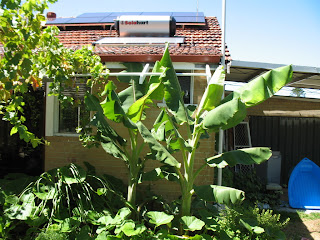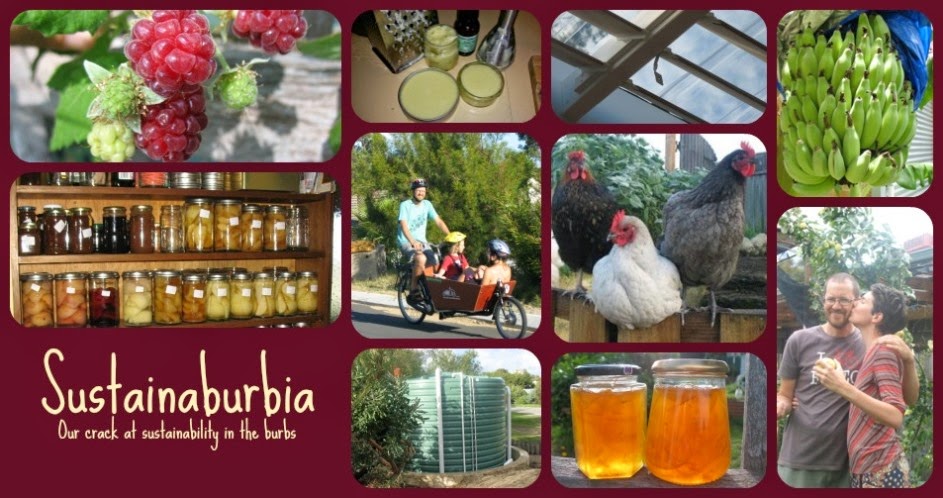It's been a year now since we got a solar hot water system. As is my wont, I took weekly readings of our gas meter and set up a spreadsheet (gas-o-lean) to see what was happening. So here's the dirt: we cut our gas use by two thirds in one year! We also cut our gas bill from $470 to $200.

Our old hot water system was a 90L gas storage. It was fairly old and cladding the dunny wall would have been pretty hard with the tank in the way. So I looked in to the alternatives. Wood is a good sustainable option for combined heating and cooking and hot water, but it's not that easy or cheap to get wood in the city and we don't have much space for storing it. It also doesn't seem practical in Perth's hot climate, where lighting a fire in summer for a bit of hot water seems crazy. The next option we considered was instantaneous gas (IG). I'd been told that for low hot water users such as ourselves this might be best when taking into account the embodied energy aspect. This means that although more energy is used to heat water via IG than via solar, the larger embodied energy in solar systems can mean they are less sustainable than they appear (the energy used to manufacture solar systems takes a long time to be paid back by the solar generation). The last option we looked at was of course solar, which is a popular choice for many in one of the sunniest cities in the world. This seemed like an obvious choice for us since we run our house on PV power and because it's renewable. It drives me somewhat crazy when people almost talk of gas as renewable (just because it's cleaner than coal doesn't make it clean!). Solar just makes sense to me, you pays your money and you forget about it for 25 or so years. So despite some advice to the contrary we opted for solar.
You'll see in the photo above that we oriented the panel in landscape rather than the normal portrait fashion. This was because our roof has two pitches, with the upper two thirds steeper than the lower third. We wanted to get the panel at the steeper pitch because this maximises solar radiation in winter, which in Perth (as in most places) is when you get the least sunshine. The lower angle of the sun in winter means you need a steep pitch to get the most solar gain. In the end the panel bridged both pitches because the installers couldn't put the tank any closer to our PV panels. Unlike grid connect PV, where the main concern is generating the most power irrespective of time of year, solar hot water is all about getting the most heat out of the sun on the most days (since you can't store or feed the power elsewhere). This then minimises the amount you need to boost the hot water and maximises the efficiency of your system. In fact, if I were to build my own house I would consider having a roof at 25 degrees pitch for PV and a separate roof at 45 degrees for solar hot water.
Choosing solar was just the beginning. Would we go for a roof mounted tank or not, 180L or 320L, glycol panels or water, gas or electric boosting, stainless steel or ceramic tank, etc.
Roof mounting is a no brainer for me. Why would you want to defy gravity and use power to pump water from a tank on the ground to panels on the roof when you can use gravity to do all the work for you by mounting a tank on your roof? Roof mounted tanks (also known as thermosiphon systems) use less power and are more reliable (no pumps, etc to break down) so that's what we have. As the water in the panels heats up it rises into the tank, as the water in the tank cools it falls to the bottom and back into the panels.
We don't use much water, so my feeling was that 180L would be plenty and it turns out it is. I didn't appreciate it at the time we purchased, but having a 320L tank doesn't mean you have more hot water. It means you have more water at the same temperature as a 180L system, which isn't much help if you need to boost in winter (in fact you'll end up paying more for boosting a larger tank). This is because a 180L tank is installed with 1 solar panel and a 320L tank is installed with 2 solar panels, because it suits the tank size. Having 2 panels and a small tank would mean overkill for 9 months of the year and having 1 panel with a large tank would mean tepid water for 9 months of the year. So getting a larger tank means you have more water, not hotter water. As long as 180L is enough hot water, there is no point getting a larger system. Since we use 200-300L water a day in the house, this probably equates to about 100-150L at most of hot water and much less in summer (the hotter the water the more cold water it is mixed with to make it safe and usable).
The solar collectors are either filled with glycol or water. I don't understand this in too much detail, but we opted for glycol since they are more efficient and when they get to a certain temperature they shut off, whereas with water they can't shut off and the tank may need to purge (let off hot water) in summer, which is a waste of water. I had a look at evacuated tube technology, but my feeling is that it's mainly designed for cooler climates and that it wouldn't be worth the extra money in Perth.
The boosting system is an interesting one. Many people are advised to get IG as the boosting system for SHW (in fact you can't access some government rebates unless you gas boost), since gas is a more efficient way to boost than electricity. Modern IG systems are very efficient these days, partly because they don't have a pilot light burning 24/7, they have an electronic ignition which only lights up when you need it. Electric boosting works just like a kettle, there's an element in the tank which heats the water. We opted for electric boosting, partly due to cost ($1,500 less) and partly because I wanted to be in control of the boosting. I want to know when we've run out of solar hot water because then I can change my behaviour to suit the conditions. For instance I can skip a shower or wash the clothes on cold. With gas boosting you never know when you're on solar or gas because it just cuts in when the tank water reaches a certain temperature. This means you have no feedback loop from the hot water system and you can't change behaviour accordingly. This is a big deal for me, since cutting my emissions is the main reason I'm doing this. Also, I've worked out it costs me about $20 a year to boost. Let's say gas cost half this ($10) and IG systems last 15 years. This means IG saves me $150 over that time, but costs me $1,500 (a $1,350 loss). Doesn't seem too economical to me! The fact that I am sometimes inconvenienced because I have to wait 30 minutes for the booster to heat my water is not that big a deal.
Lastly we had to choose between stainless steel tanks and ceramic lined tanks. Ceramic lined tanks have a sacrificial anode in them which corrodes over time to protect the tank from impurities in the water. You need to replace these every 5 years and then the tank should last 25-30 years. Stainless steel tanks don't have an anode since they are supposedly rust proof. In reality even stainless steel has imperfections and sometimes can rust, in which case you need to replace the whole tank. We went for the ceramic type for peace of mind. I know I won't forget to get the anode checked and I just think the tank will last longer. The company we used are Solarhart, which is an Australian owned and manufactured product.
Here is a our weekly gas usage with and without solar.We use gas for heating, cooking and hot water. We use most in winter, mainly due to heating but also because water in the hot water tank cools more rapidly in winter.We cut our usage from 11.3 kWh a day to 3.7 kWh a day (by the way, if you're in WA and want to convert the units on your meter to kWh, multiply them by 11.3 (don't ask me why!)). This means that heating water used approximately two thirds of our gas (assuming our gas use for heating and cooking were similar in both years). We've had a solar oven for the last year but I don't think that would have reduced our gas use that much. If you're wondering about the weeks in summer in year 2 being as high as year 1, those were preserving weeks when we were using the gas hob for big batches of tomatoes and other fruit.

Converting to kWh is good because you can then calculate your combined gas and electricity use in the same units. I was interested to see this since our boosting with electricity would have bumped up our usage a bit. I estimate that we used roughly an extra 0.5 kWh of electricity a day for 22 weeks between May and September to boost our hot water. Overall, we cut our power usage almost in half by getting SHW, from 15.6 to 8.2 kWh a day (see running average chart below). This is roughly half the consumption of low users stated by Living Smart for a family of 3 people in Perth, which means we use about a quarter of the 'average' family's consumption.

What about the economics? Our system cost us $3,500 after rebates. We made a saving of $290 on our bills in the first year, which comes to $270 after deducting boosting costs. Assuming gas price rises of 5% a year this means a payback time of 10 years for us. This means we should get 14-19 plus years of free hot water and savings of around $17,000 over 30 years ($13,500 after initial costs). Most people would pay off much more quickly though, with some high users paying off their costs in 3-4 years. Our combined electricity and gas bills should be between $0 and $50 for the next 9 years (this will increase when the electicity Feed in Tariff expires). I feel the $10,000 we invested in PV and SHW was money well spent, since we'll have very low bills for the next 25 years at least. In uncertain economic times this is a good thing. If the GFC Mark II comes sooner rather than later, I could lose my job but at least I wouldn't have to worry about huge utility bills.
How far behind peak oil is peak gas? I'm not sure but I'm pretty confident it's a fair way until peak sun...


